
What is Hot Pot?
In short, hot pot is just a pot of boiling broth in the center of the table with a large variety of ingredients (usually raw) laid out buffet-style that you use to cook in the broth on the fly.
Once the food has finished cooking, you scoop it out onto your bowl which will have a personalized dipping sauce that you created, and you eat it! 🙂
Hot pot is a warm and comforting communal meal that is shared amongst family and close friends but because of the social aspect of it, it is also great to entertain big social gatherings with as well, especially during Chinese New Year.
Since the food is cooked in real-time and enjoyed hot straight out of the broth in small batches, it means that it's usually a longer meal so you can chit-chat with friends and family while you are enjoying the food.
Although it may look fancy and somewhat overwhelming, hot pot can be easily customized to be as simple or as elaborate as you want it to be! The more people you have, the more variety of ingredients you can put out to share.
I personally do hot pot for 2 a lot in the winter as my lazy dinners. I just prepare a small number of ingredients to eat, use a bouillon as my broth, and Voila! Dinner in 10 minutes.
Chinese Hot Pot Cookware
- I highly recommend using an electric portable induction cooktop to do hot pot with. It's easy to use, super quick to clean up, and safe to use. When using an induction stovetop, you're going to want to make sure that your pot is magnetic. I found that any type of steel or stainless steel pot will work. If you are not 100% sure if a pot will work with it, just stick a magnet to it. If the magnet sticks to it, you're good to go.
- Alternatively, you can also use a portable gas butane stove as well. You will need to buy gas canisters in order for it to work but you won't have any long cables or plugs laying around to trip over as well.
- Last but not least, there are also portable electric hot plate burners as well, these are the least expensive option but they also take longer to heat up and are not as good at maintaining a consistent heat.
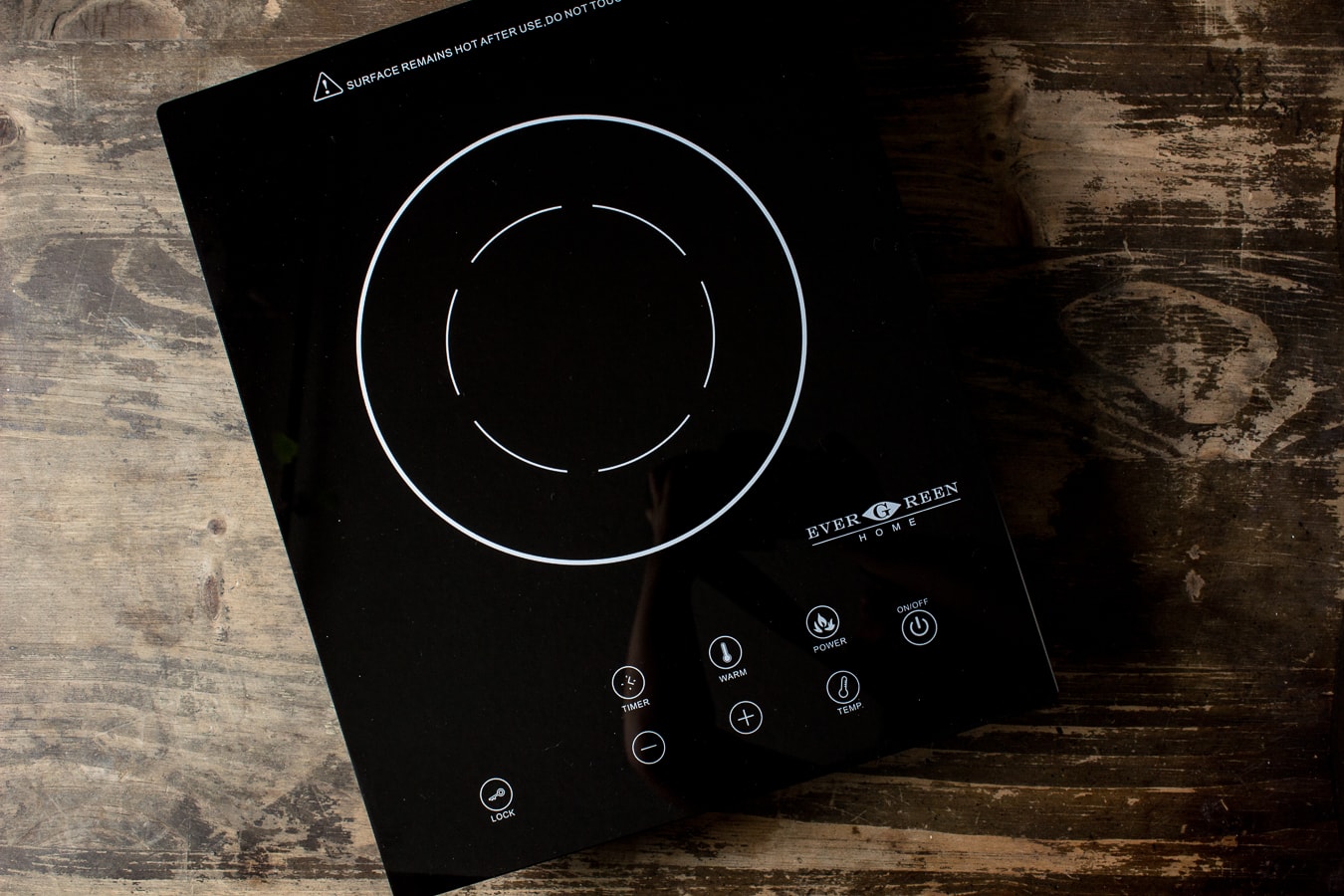
Once you picked a cooktop, you will need to use a large metal pot to cook things in.
Traditionally for hot pot, we use a specific type of pot with a divider in the middle so that you can have a spicy, and non-spicy broth to cook the food in. You can also put 2 completely different soup bases in them if you don't like spicy foods.
If you can't find this type of pot, or don't want to store a pot just for hot pot you can use any type of metal pot that you use for cooking - just make sure it has tall enough walls to hold the broth so that it doesn't spill over while it's boiling.
Hot Pot Tools and Utensils
A very useful tool for hot pot is a hot pot strainer scoop - each person would get their own scoop at the table. This scoop is very helpful with fishing out slippery and hard-to-grab foods out of the pot and into your sauce bowl.
If you can't find these mini hot pot scoops or you don't want to purchase them, you can use a ladle with holes or a spaghetti/noodle ladle as well.
Other than the hot pot basket scoop, you can pretty much use any type of utensil you feel comfortable eating with such as wooden chopsticks or forks - if you plan on using metal utensils make sure you don't use it to cook the food from the pot since metal conducts heat and it can get really hot.
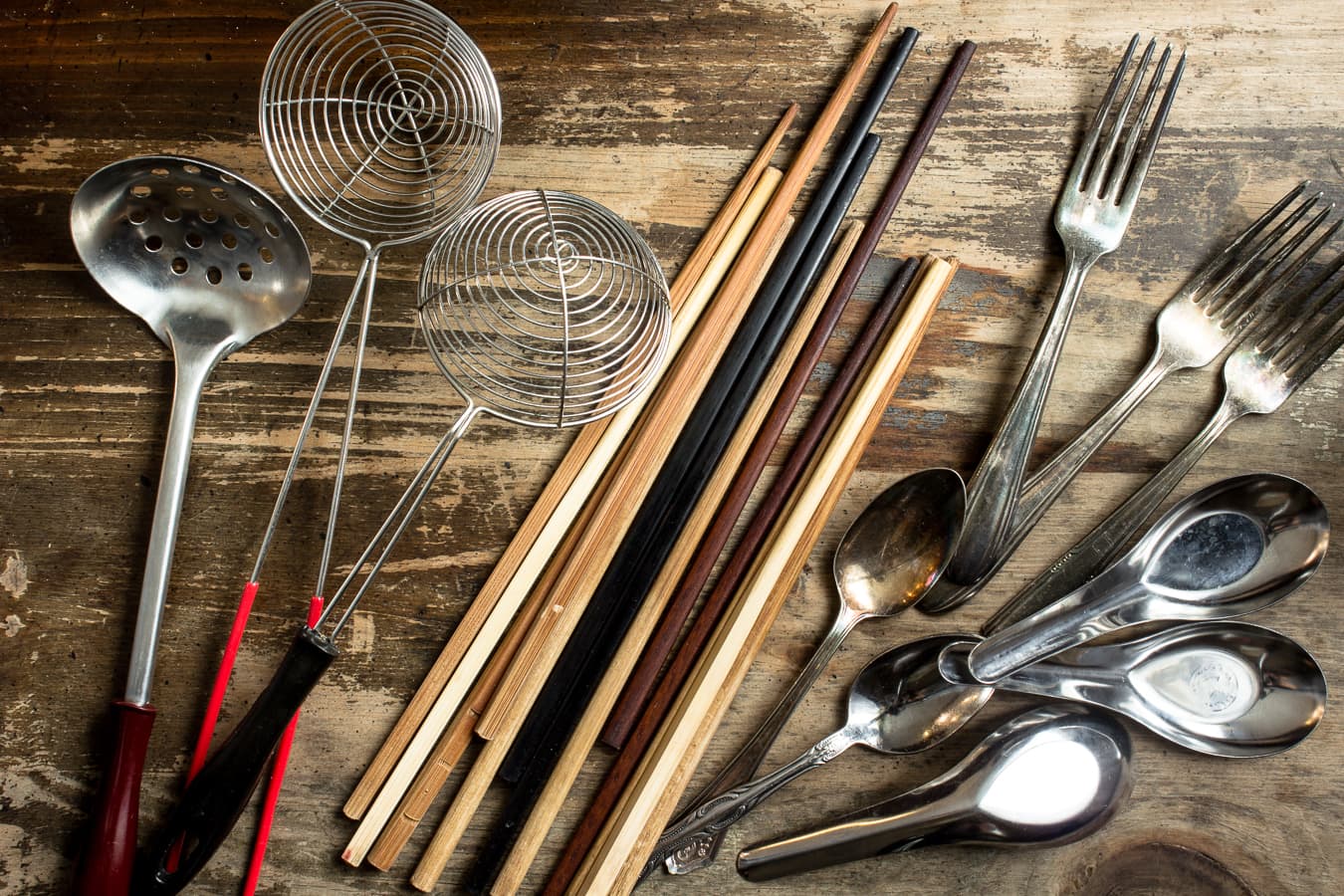
Chinese Hot Pot Ingredients Ideas
For hot pot ingredients, there are no hard and fast rules for what to use. Honestly, the sky is the limit. Traditionally, you would use raw meats but to be honest, I have used ingredients like cooked sausages, hotdogs, and even spam! 😛
Here are a few ideas to start you off and I highly encourage you to expand this list to find what you enjoy most 🙂
Meat & Seafood
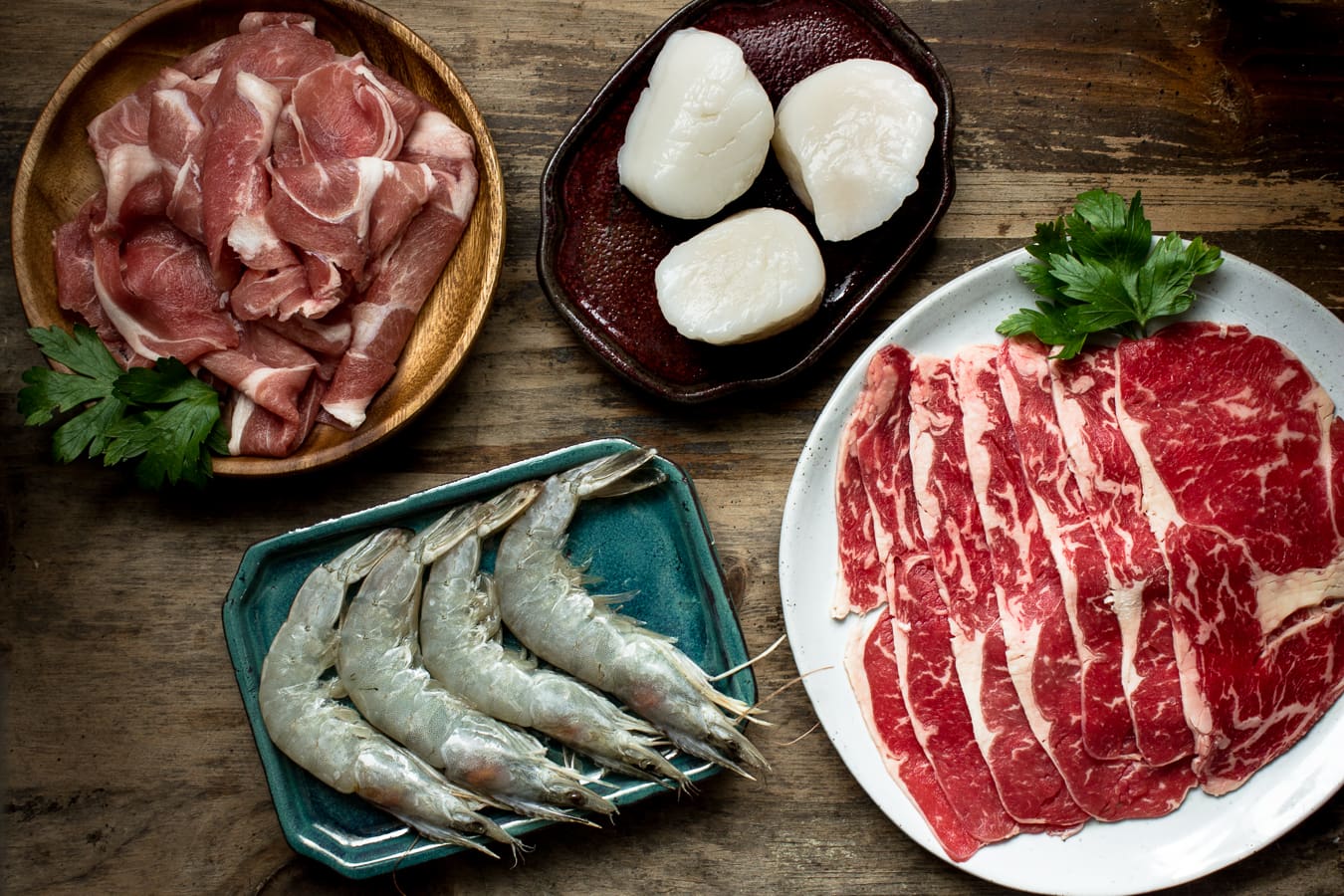
When it comes to hot pot meat, you can either prepare them fresh yourself from scratch by slicing your own meats and fish, or you can buy pre-prepared ones that are sliced very thin.
I like to buy the pre-prepared meats mostly because it's easier and they cut them very thin. The thinner the meat, the faster it will cook which makes them great snacking on for while you are waiting for the longer to cook ingredients to finish cooking.
- Shellfish (Frozen or Fresh) - Shrimp, Scallops, Crab, Lobster, Oyster, Mussels (New Zealand), Clams
- Thinly Sliced Beef and Lamb
- Beef Tripe - Tripe is a great ingredient since its texture makes it a great sauce carrier.
- Pork - Slices of pork shoulder, bacon, and pork belly.
- Chicken and Turkey - Thin slices of chicken breast marinated in a bit of soy sauce, oil, and corn starch to prevent overcooking. The cornstarch also helps with velveting it so it keeps it a nice slippery texture.
- Fish (Frozen or Fresh) - Salmon, Basa Fillet, or any type of fish. I like to slice them thick, around ½ inch so they don't fall apart in the hot pot.
- Squid or Octopus - This may be a hit or miss because of how chewy it can be if you overcook it.
Vegetables and Mushrooms
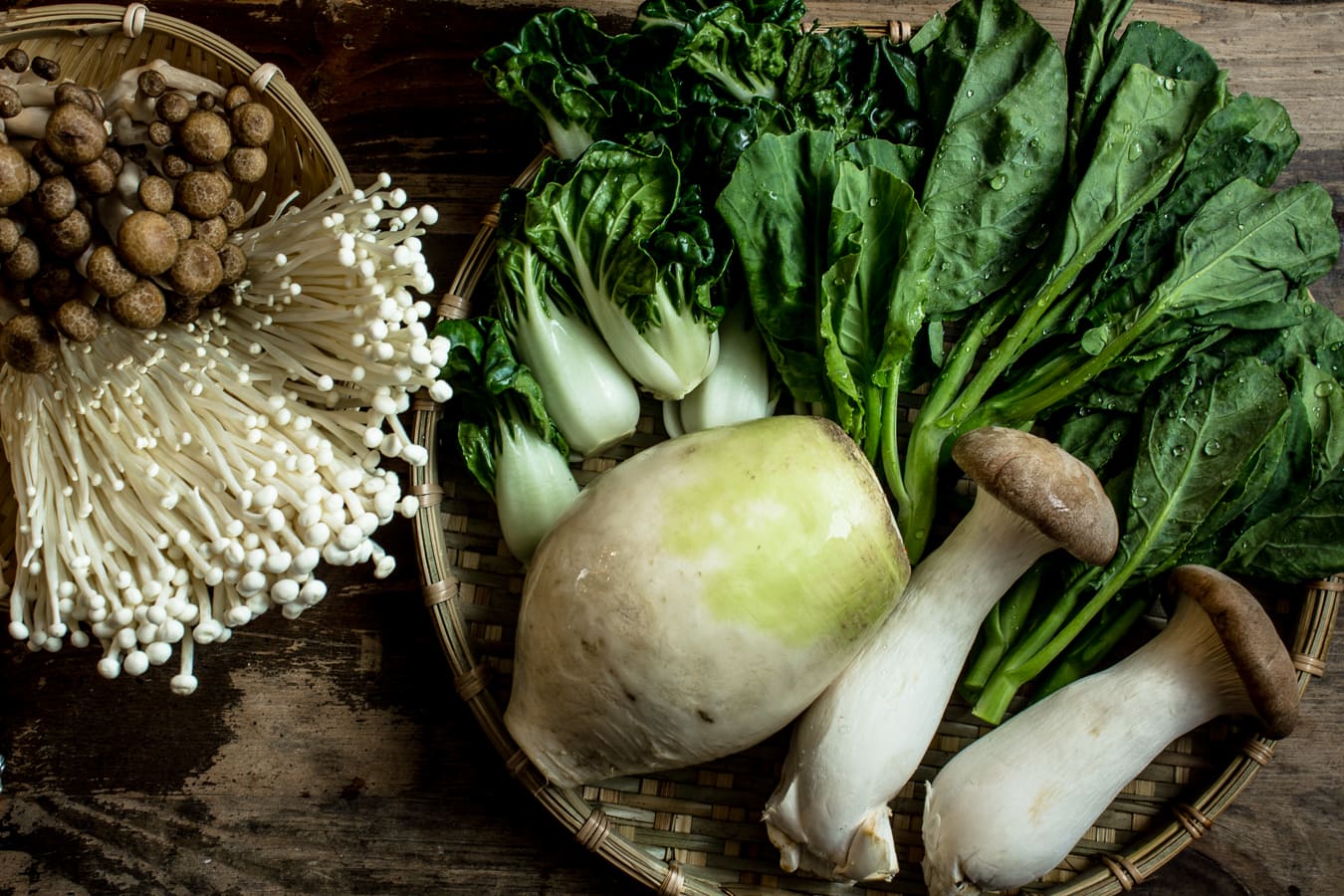
When you are preparing vegetables like root vegetables or very hard vegetables like carrots, you want to make sure you are cutting them into small pieces (I usually like cutting things into 2 inch pieces) so they can cook more quickly and more easily.
- Chinese Greens - Any type of Chinese Leafy Greens such as Napa Cabbage, Tong Oh, Taiwanese A-Choy Lettuce, Snow Pea Tips (the leaves), Watercress Greens, Bok Choy, Gai Lan, Yu Choy
- Mushrooms - Enoki mushrooms, Oyster Mushrooms, King Oyster Mushrooms, Shimeji Mushrooms, Seafood Mushroom, Button Mushrooms (cut in half), Shiitake Mushrooms (fresh or dried, dried shiitake will need to be soaked ahead of time until it's soft)
- Root Vegetables - Daikon Radish, Korean Radish, Taro, Lotus Root
- Chinese Garlic Chives - Cut into 2-inch strips.
- Legumes -Snow Peas, Sugar Snap Peas, Bean Sprouts
- Asparagus - Cut these into 2-inch pieces so that it's easier to eat and cook.
- Baby Corn - These are the baby corn that comes in a can. They have a lot of texture, so they make excellent sauce carriers.
- Chayote - I like to use chayote as an alternative to daikon radish. It's very sweet and quite filling as well, so a few will go a long way. To prepare it, remove the pit by cutting the chayote in half, and then cut out the pit at the bottom. Then I cut them into 4-6 pieces depending on how large it is.
- Other Vegetables - Red, Yellow, or Green Peppers cut into strips, Brussels Sprouts cut in half, Cabbage, Carrots, Brocolli, Cauliflower, Zucchini, Kale, Corn (Cut in 3s or 4s)
Noodles, Tofu, and Pre-made Balls

- Noodles - Udon, Thick rice noodles, Instant Ramen Noodles (without the flavor packs), Vermicelli Noodles, Shirataki Yam Noodle Bundles, Mung Bean Glass Noodles, Sweet Potato Glass Noodles. If you're looking for something chewy you can also use rice cakes as well but don't use too many, because the starch can thicken the broth.
- Bean Curd Skin Rolls - These are great for absorbing sauce, but you need to soak them ahead of time in hot water for about 20 minutes to a few hours, or else they will take a very long time to cook through. Buy the bean curd sticks, which hold their shape better in hot pot. The bean curd flat skin sheets are too delicate and will break apart in hot pot.
- Wontons and Dumplings (Fresh or Frozen) - Any type of dumpling works very well in hot pot. My personal favorite is the very large shrimp wontons.
- Deep Fried Tofu Balls - Since they are pre-deep fried, they have a bit more texture on the outer layer which helps the sauce stick to it.
- Fresh Tofu (Medium or Hard) - Fresh tofu has a more clean and more refreshing flavor than the deep-fried versions. Try to find medium or hard-textured ones so it doesn't break easily while it's cooking inside the hot pot with other ingredients.
- Gluten Balls - Gluten balls come in many forms and are usually in the fridge section of Asian grocery stores where the fresh noodles are. They come in smooth balls, textured crunchy-looking balls, and square cubes that look like dried cubes of bread.
- Fish Cakes - These come in different sizes, and you can cut them up into smaller rectangles or square pieces to make them easier to cook and eat.
- Meat Balls - These are a staple in hot pot. They come in a variety of proteins like beef, fish, pork, and lobster. Some even come stuffed with meat or cheese! Definitely have fun with this one and try a variety of them until you find your favorites. My personal favorite is the fish balls stuffed with pork.
Non-Traditional Ingredients
Chinese hot pot is such a fun and versatile way to eat, and it's definitely not limited to just the common and traditional ingredients! Have fun with it and experiment with the ingredients. Here are a few random ingredients I have used that I enjoyed!
- Hotdogs - Cut into 1-inch pieces.
- Spam - I like to cut them into ½-inch strips. The saltiness is delicious.
- Chicken Wings - If you have whole chicken wings, cut them into 3 separate pieces at the joint to make it easier to cook and eat. You can also buy them pre-cut which usually gives you just the flats and the drumettes.
- Thick Slices of Ham - I like to cut them into ½-inch thick strips. I usually buy the small whole ham and slice it myself, instead of using the thin sandwich meats because I can taste it a lot better. That being said, you can also use the thin sandwich meat ones as well. I usually use ham when I have leftovers.
Hot Pot Sauces
Although a good broth is important, I personally find the hot pot dipping sauces even more important since this is what is going to flavor most of your foods.
There's no hard and fast rule on how your dipping sauce should taste, and you are not limited to only one type of dipping sauce - so mix and match it to make your own personal mix in your bowl and have fun with it! 🙂
Whether you like your sauces, sweet, spicy, tangy, or just savory here are a few popular options that you can use to set up your sauce stations!

1.) Raw Egg 2.) Sriracha/Sambal Olek 3.) Oyster Sauce 4.) Sesame Oil 5.) Chinese BBQ Sauce (aka Shacha Sauce/Satay Sauce) 6.) Soy Sauce 7.) Green Onions 8.) Sesame Seeds 9.) Chinese Sesame Paste 10.) Chinese Black Vinegar 11.) Chili Flakes 12.) Rice Wine Vinegar 13.) Chinese Chili Oil 14.) Hoisin Sauce
I highly recommend using Chinese BBQ Sauce (Shacha Sauce) if you can get a hold of it. You can find this online or at a Chinese grocery store.
Hot Pot Soup Bases
Although the hot pot broth is important in a hot pot recipe, I personally find I get most of my flavors from the personalized dipping sauces in our bowls. Personally, I think a hot pot recipe shouldn't be something you are slaving over for hours so I like to keep things simple, quick, and easy.
That being said, I do provide an option below to give your hot pot broth a bit more depth but it will have a longer cooking time as well for those of us who are okay with taking a bit more time with it - the bonus to making a broth from scratch is that you can drink the soup afterward.
1. Simple Broth (The Foundation Broth)
For this simple broth, just throw everything in a large pot and boil away! Once it's been simmering for 30-45 minutes, strain everything out!
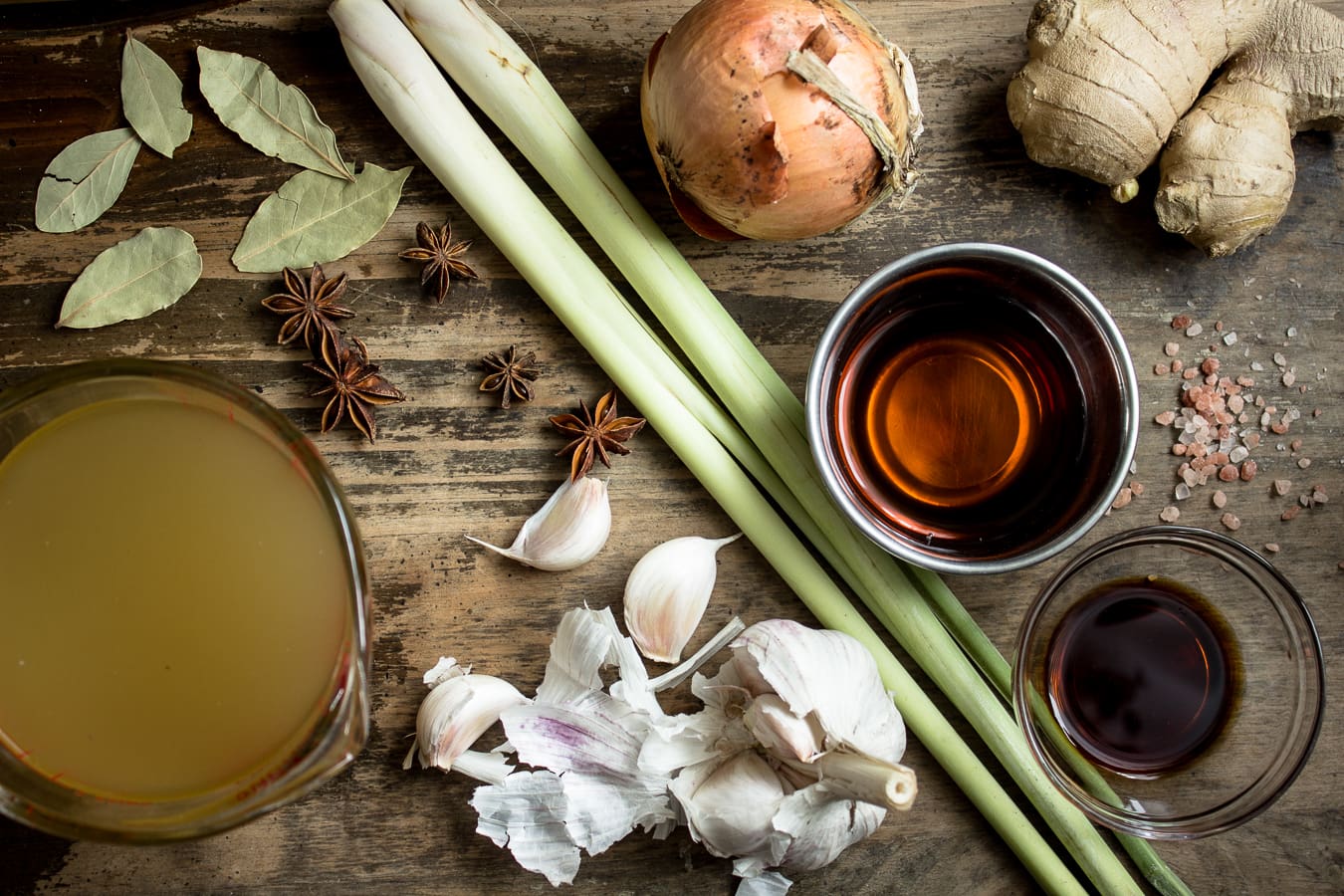
2. Silkier Broth (Optional, Will Require More Cooking Time)
When I have time, I like to give my foundation broth a bit more substance by adding pork hocks. When the connective tissues break down in the broth it gives the broth a slightly thicker and silkier consistency.
Connective tissues take a while to break down so to speed up the process of this broth, you can start it off in a pressure cooker as well. If you have a butcher, ask them to cut the pork hocks into smaller 2-3 inch chunks so that it cooks faster - if you don't have a butcher you can cook the pork hock whole, it will just take a bit longer.
3. Spicy Broth
Whether you are using the hot pot recipe for the simple foundation broth or the silkier broth, to get it spicy you just need to pan-fry dried chili flakes with a bit of oil. The oil will turn red and become mildly spicy, and you can pour the spicy oil into the hot pot broth when you're ready to start.
If you are feeling fancy, you can even add additional spices (star anise, cinnamon, etc) into the oil while you are pan-frying it. If you want it even spicier, add a few fresh birdseye chili peppers to it.

4. Instant Hot Pot Broths
Alternatively, you can skip making your own hot pot broth and use these quick and pre-made sauce bases below to make an instant broth! Use 1-2 tablespoons to start, and do a taste test - adjust it to your liking after.
- Instant Tom Yum Paste - this wonderful paste will give you a sour and salty broth. You can add a bit of sugar to it to give it a sweet, sour, and salty balance as well.
- Miso - When you dissolve the miso paste into the pot of water, you have a simple, salty, and umami soup base
- Red/Yellow Thai Curry Paste - A little will go a long way, but this will give you a bit of a spicy kick. Add a bit of coconut milk to give it some more flavor.
- Hondashi Dashi Powder - this will give you a simple smoky broth.
- Gochujang - if you're looking for a sweet and spicy broth, use gochujang.
- Chicken Boullion/Chicken Powder - A simple chicken flavor broth. You can add a few slices of ginger and sesame oil to this to give it a bit more flavor but remember to discard it before you start hot pot.
- Store-bought soup base - This is the easiest and quickest way to make a soup base and there are many different types available from herbal, to spicy Mongolian to spicy Sichuan. If you're looking for a no fuss and flavorful soup broth, this is definitely the way to go.
How to Setup Up Chinese Hot Pot
- Provide each place setting with a small plate with a hot pot scoop, chopsticks, a bowl (this will be their personal sauce bowl), and napkins
- Place the cooktop in the middle of the place setting, making sure everyone can reach it easily.
- Prepare all the ingredients.
- Wash the vegetables and mushrooms, and cut them into smaller pieces if needed.
- Cut the starchy and root vegetables into small pieces. The thinner or smaller you cut them, the faster they will cook. Hand rip or cut the mushrooms into bite-sized pieces.
- Soak the vermicelli or glass noodles for 1 minute in cold water.
- If you are using frozen shrimp or scallops, make sure you defrost them ahead of time, or else they won't cook evenly because of their frozen centers.
- If you are buying pre-sliced hot pot meat, remove it from the packaging and place them on plates - if you are using fresh meat, slice them thinly and place it on plates.
- If you are using fresh chicken or fish, slice them thinly and marinate them in ¼ tsp of corn starch and some soy, this will prevent it from overcooking and it will make it a silkier texture.
- When you are plating the ingredients, make sure you group similar things together. (ie, Place meats with meat only preferably in separate plates by type, seafood on their own plates, vegetables can be put together, and balls/noodles/tofu/dumplings can be placed together.
- Place all the raw ingredients around the cooktop. It's okay if everyone can't reach everything, you can either place the ingredients in the hot pot for them if you are closer to it. Make sure you have separate utensils for the meat and seafood so that you don't cross-contaminate your personal chopsticks/eating utensils.
- Place a pitcher or glass of water close by. Depending on how long you do hot pot for, your soup base will eventually evaporate and you will lose a lot of liquid in the pot. When the broth starts to hit the halfway point in the pot, add the water in and wait for it to re-boil again before you start cooking.
- Prepare your soup bases and pour it into your pot. Bring the pot over to the cooktop and turn on the heat. Wait for the soup base to boil and you're good to go! The soup base must always be boiling before you can start cooking the food.
- At our home, we do our sauce station in the kitchen and bring over our sauce bowl to the hot pot area once we have mixed our sauces together. It's a lot easier that way, everyone can just put in what they want, and then we can throw all the sauces back in the fridge afterward, it also doesn't clutter your eating area.
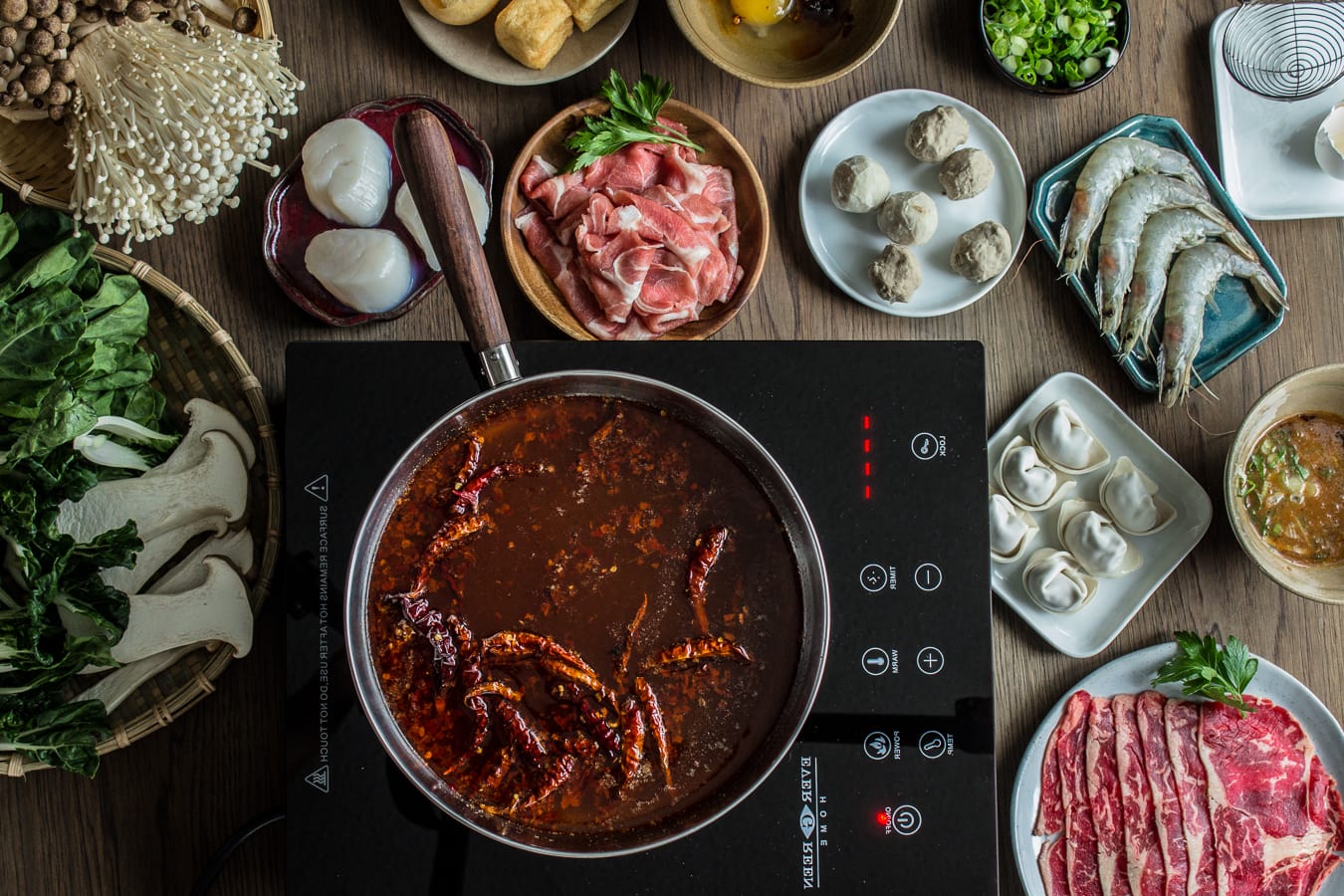
FAQs
Only cook what you plan to eat and in small amounts. We usually like to do things in batches, so for example, if we are going to cook shrimp, we ask everyone who wants shrimp and we put in only the amount that is being eaten. That way we know that all the shrimp will cook at the same time and you won't have any leftover overcooked shrimp sitting in the pot during the whole meal. The only exception is the frozen paper-thin meats, since they only take 30 seconds to cook, these are usually cooked on the fly by whoever is going to eat them right away.
This will depend on what you are cooking. Here is a rough guideline on the cooking times we use at home.
- Dumplings/Balls - We cook these for about 2-4 minutes. We know it's done when it has floated to the top of the broth.
- Meats - If you are using store-bought pre-sliced frozen meat, they only take 20-30 seconds since they are paper-thin. I usually put it in, wiggle it in the broth to loosen it up, and pull it right out. It may look a little pink sometimes but the residual heat continues to cook it and it's safe to eat as medium rare as well. If you are using meats you sliced yourself, the meat will be thicker and will take more time to cook, I usually cook it for about 1-2 minutes assuming that the meats have been sliced ¼ inch thick.
- Noodles - If you are using glass noodles or thin vermicelli, I cook them for about 30 seconds to keep them chewy (if you pre-soaked them in cold water) - cook it longer if you are cooking it from dry form. Shirataki noodles can stay in the broth for as long as you want and they will never break down - the longer you cook it in the broth the more flavorful it will be. If you are cooking frozen udon bricks, I usually cook it until the noodles have separated from brick form and cook it for an additional 30 seconds to keep it chewy. If you are using dried noodles, cook them according to the instructions.
- Tofu - You can cook this for as long as you like unless you're cooking soft tofu. We cook soft tofu for 1-2 minutes.
- Seafood - Any type of seafood should be done around 2 minutes except for lobster, crab, and oysters. Oysters, depending on the size can be cooked for up to 7 - 10 minutes if they are on the larger size. Lobster and crab can take about 5 minutes. For shrimp, we know it's down when it has curled into a C shape, if it's an O shape, it's overdone but still tasty. Scallops take about 5-7 minutes depending on the size as well.
- Vegetables - Most leafy vegetables will take less than 1 minute. Starchy and root vegetables can 10-15+ minutes depending on how thick you cut them. Mushrooms take 1-2 minutes.
Follow me for more foodie articles like this!
This article originally appeared on Pups with Chopsticks.

Leave a comment